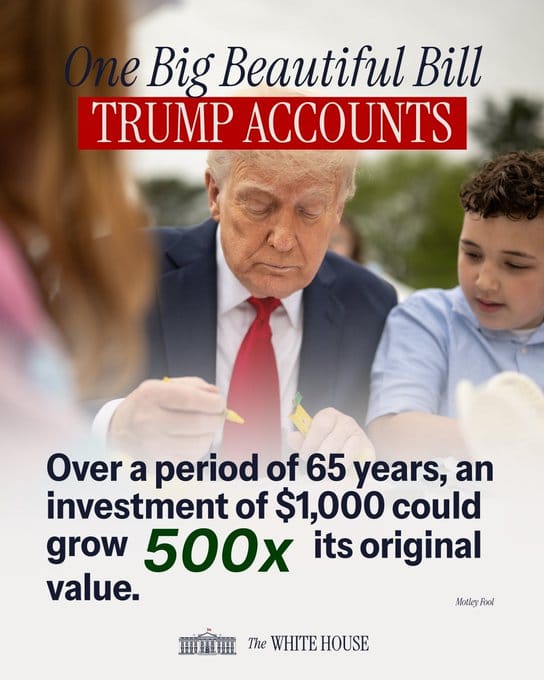In 2025 Congress approved a landmark tax-and-spending package – branded by Republicans as the “One Big Beautiful Bill” – that includes a provision to create Trump Savings Accounts for children. Under the new law, every eligible American baby born during the plan’s first five years would have a government-seeded investment account opened in their name. The Treasury Department would deposit $1,000 into each account at birth. Parents or guardians could then add their own contributions (up to $5,000 per year) into a low-cost stock index fund, with earnings growing tax-deferred. Proponents say this gives children a head start through “the miracle of compounded growth” in the stock market, while critics question whether a one-time $1,000 bonus can meaningfully close wealth gaps or serve needy families better than other programs.

This article explains exactly what Trump Savings Accounts are, traces their legislative history, and details how they work – from eligibility to investments, contributions and tax rules. We also examine why advocates tout these accounts as a new pro-family policy and how experts warn they may affect Americans.
What Are Trump Savings Accounts?
“Trump Savings Accounts” (often called “Trump Accounts”) are newly created child investment accounts established by federal law. The idea is to give each eligible child a tax-advantaged savings account invested in a broad U.S. stock index fund. At birth, the government seeds each account with a $1,000 deposit. The child’s parent or legal guardian controls the account (they manage the investments, which must follow strict rules). After the initial $1,000 deposit, families can make additional contributions – up to $5,000 per year in after-tax dollars – into the child’s account. Over time, the money in the account stays invested in a diversified, low-cost equity index fund, allowing children to accumulate savings through the power of compound interest.
Trump Savings Accounts for Children
Trump Savings Accounts for children offer a unique opportunity to build wealth over time, providing a financial resource for significant life milestones. The initial $1,000 investment, combined with potential parental contributions, can grow substantially through compound interest. Estimates suggest that, with average market returns, the account could reach approximately $8,000 by age 18, offering a meaningful sum for education, starting a business, or buying a home.
Beyond financial benefits, Trump Savings Accounts for children encourage early engagement with financial markets. By introducing children and their families to investing, the program fosters financial literacy and responsible money management. This initiative could lead to increased economic mobility, as children have access to funds that reduce reliance on loans or other debt for major expenses.
Trump Savings Accounts for Newborn Babies
Trump Savings Accounts for newborn babies ensure that every eligible child starts life with a financial asset. Newborns born between January 1, 2025, and December 31, 2028, automatically qualify for the $1,000 government contribution, regardless of their family’s income level. This universal approach aims to promote equality of opportunity from birth. The automatic enrollment feature is particularly significant, ensuring that even families who may not immediately open an account can benefit from the program. This provision underscores the government’s commitment to providing every child with a financial foundation.
Trump Savings Accounts for Parents and Guardians
Trump Savings Accounts for parents and guardians place significant responsibility on families to maximize the program’s benefits. Parents or legal guardians are tasked with opening and managing the accounts, making additional contributions, and guiding their children on the prudent use of funds. The ability to contribute up to $5,000 annually allows parents to tailor savings to their financial capacity and goals. Moreover, the program serves as an educational tool, enabling parents to teach their children about investing and financial planning, fostering a culture of long-term financial responsibility.
FAQ for Trump Savings Accounts
- What is a Trump Savings Account?
A tax-advantaged investment account for newborns, seeded with a $1,000 government contribution, invested in a U.S. equities index fund for education, homeownership, or business purposes. - Who is eligible for a Trump Savings Account?
U.S. citizens born between January 1, 2025, and December 31, 2028, with at least one parent holding a work-eligible Social Security number. - How can I open a Trump Savings Account for my child?
Parents or guardians can open an account through participating banks or financial institutions with necessary documentation. - Can I contribute more than the initial $1,000?
Yes, up to $5,000 annually with after-tax dollars. - When can funds be withdrawn?
Starting at age 18 for specific purposes (education, business, home purchase), with full access at age 30 for any purpose. - Are there tax benefits to Trump Savings Accounts?
Growth is tax-deferred, but contributions and distributions are taxable. - How do Trump Savings Accounts compare to 529 plans?
529 plans are for education with tax-free withdrawals; Trump Savings Accounts allow broader uses but with taxable distributions. - What happens if I don’t open an account for my child?
The government may automatically open an account to ensure eligibility. - Can employers contribute to Trump Savings Accounts?
Yes, up to $2,500 annually, excluded from gross income. - Is the program available for children born outside the specified dates?
Currently limited to the 2025-2028 period; future expansions may occur.
Eligibility for Trump Savings Accounts
To qualify for a Trump Savings Account (i.e. to get the $1,000 seed deposit and an account set up at birth), a child must meet all the program’s criteria, which generally are:
- Date of birth: The child must be born in the United States after Dec. 31, 2024 and before Jan. 1, 2029. In other words, eligible children are those born in calendar years 2025 through 2028. (Children born in 2029 or later would not automatically receive the seed deposit, although the law authorizes future extensions.)
- U.S. citizenship: The child must be a U.S. citizen at birth. (Permanent residents or non-citizen newborns would not qualify for the deposit under current rules.)
- Parental work status: At least one parent or legal guardian must have a valid Social Security number and work authorization in the U.S.. In other words, undocumented parents would render a child ineligible for the benefit. This mirrors existing rules in the Child Tax Credit (for example) that require parental Social Security numbers.
- Account opening: Only a child’s parent or legally appointed guardian can open and manage the account on the child’s behalf. The child cannot open it themselves (of course) and any contributions or investment decisions must go through the adult. In practice, most families would simply opt in at birth.

According to the law, if an eligible child does not have an account opened for them (for example, if parents fail to sign up), the Treasury Secretary is empowered to open one automatically on the child’s behalf. The government could use birth records and tax filings to identify newborns and set up the accounts. Once opened, families could also decline or withdraw from the program, but the $1,000 government seed money is a one-time incentive.
In summary, the Trump Savings Accounts for newborn babies target essentially all U.S.-born children whose parents have valid SSNs, born in the 2025–2028 window. The requirement to have a work-authorized parent means the plan is explicitly for children of U.S. workers. Both children of wealthy Americans and those in lower-income families are eligible. That universality is an intentional feature: unlike state “baby bonds” programs (which often target low-income kids), the Trump accounts will be available regardless of family income.
Investment and Withdrawal Rules
The law imposes strict rules on how Trump Savings Account funds can be invested and spent. In essence, the accounts resemble a locked-up investment vehicle until the child reaches young adulthood. Key points include:
- Index Fund Requirement: All new contributions to Trump Accounts must be invested in a diversified, low-cost U.S. stock market index fund. The White House plan specifies funds that “track an established index of U.S. equities” and forbid leverage or exotic instruments. This means each account should hold broad-market equity funds (for example, funds tracking the S&P 500 or total stock market). The goal is to give children a stake in the overall economy.
- No Withdrawals Until Age 18: Funds cannot be withdrawn or transferred in any way until the child turns 18. This lock-up period is designed to make the accounts purely long-term savings vehicles. As Kiplinger explains, “No distributions would be allowed until the child reaches 18.”. In other words, a child’s family cannot use the money for preschool, diapers, etc. until the child is an adult.
- Limited Access at Age 18: Once the child hits 18, he or she can withdraw up to 50% of the account balance, but only for certain qualified purposes. Those qualifying purposes include paying for higher education (college or vocational training), starting or expanding a small business, or making a down payment on a first home. Withdrawals for these purposes are taxed at favorable long-term capital gains rates (see tax section). Any attempt to withdraw more than 50% at age 18, or to use withdrawals for other expenses, is not allowed (or would trigger heavy taxes).
- Full Access at Age 25: Beginning at age 25, the account owner can withdraw the entire remaining balance – but still only for the same limited purposes (education, business, home). The remaining funds continue to be used for life-building goals. At 25, a young person could, for example, pay off college tuition or finance a new business, using the account like a restricted savings fund.
- Unrestricted Use at Age 30: At age 30, the Trump Savings Account fully “matures.” The beneficiary can then use the account money for any purpose. In effect, the account closes at 30 and the balance becomes just like any other asset. (Some summaries say the account automatically terminates when the holder is 31.) By then, the idea is the child has had 12+ years of investing growth.
In short, the withdrawal schedule is: 0% at birth–17; up to 50% at 18; up to 100% (for qualified uses) at 25; unrestricted at 30. This tiered approach was crafted to ensure the money goes toward long-term investments in a young person’s future, rather than short-term consumption. The administration often notes these are similar to permitted uses of education- and home-buying accounts (like Coverdell or 529 plans), but extended to more categories (small business is included here).
Contribution Rules
Parents, relatives and even other entities can add money to a Trump Savings Account, subject to annual limits. Specifically:
- Who Can Contribute: Contributions can be made by the child’s parents or guardians, any other relatives, and even certain organizations such as employers, charities or churches. In practice, this means a wide range of people or groups can help fund a child’s account. For example, companies have announced plans to participate: Dell Technologies pledged to dollar-match the federal $1,000 deposit for children of its employees, and other firms like NVIDIA have signaled support as well. The idea is an “ownership society” where not just the government, but families and communities, invest in the next generation.
- Annual Contribution Limit: The total private contributions to each account are capped at $5,000 per year. Any additional funds above that are not allowed. (Importantly, this limit applies to after-tax dollars – there is no tax deduction for giving money to the account.) Parents can direct up to $5,000 a year from their own savings into the account. Relatives could also gift money into it, or community organizations could donate on behalf of the child.
- Contribution Deadline: Contributions can only be made until the child’s 18th birthday. After 18, no more deposits are permitted. This aligns with the idea that by adulthood the account should have its final balance, ready to use under the withdrawal rules.
- Government Matching: Besides the initial $1,000 seed, there is no additional matching by the government in the basic plan. (The government only provides that one-time bonus.) However, as noted, some private employers have pledged matching. For instance, Dell said it will “match dollar for dollar the government’s seed investment” for its employees’ newborns. Other companies, like NVIDIA, Microsoft and Salesforce, have also announced contributions or plans to make deposits for their workers’ children. This corporate involvement effectively increases the child’s bonus beyond $1,000, but it is voluntary on the companies’ part.
In summary, once the account is set up, families can funnel extra savings into it to grow the child’s investment. Every year up to age 18, up to $5,000 of after-tax money can be added by parents, relatives or others. This can supercharge the account’s growth: as Invest America founder Brad Gerstner noted, just $750 extra per year (from family or community) could grow a $1,000 start into roughly $50,000 by age 18 under typical market returns.
Tax Treatment of Trump Savings Accounts
The tax rules for Trump Savings Accounts are somewhat complex, but the key points are:
- Tax-Deferred Growth: Officially, the accounts are described as tax-deferred investment accounts. This means investment growth (capital gains) accumulates without annual taxes. Practically, the government contributes $1,000 tax-free (it is not counted as income for the child), and families contribute with after-tax dollars (there is no tax deduction). The earnings in the account grow tax-free as long as they remain invested.
- Qualified Withdrawals (Cap Gains): When the money is withdrawn for the approved uses (education, home, business), the earnings portion of the withdrawal is treated as a long-term capital gain. In other words, qualified distributions are taxed at the lower capital-gains rate rather than ordinary income. This is analogous to how Roth 529 accounts work in some cases. For example, if a child uses part of the account at 18 to pay college tuition, that portion of the withdrawal would incur only capital gains tax, which is typically much lower than ordinary rates.
- Non-Qualified Withdrawals (Ordinary Income): If the account money is used for non-qualified purposes (for example, spending it at 18 on a car or vacation), then the distribution is taxed at ordinary income rates. The law also imposes withdrawal limits, so there isn’t a straightforward penalty structure – rather, unauthorized uses simply lose the preferential tax treatment.
- No Upfront Deduction: Contributions to the account are not tax-deductible for parents. Since contributions must be made with after-tax dollars, families do not get any immediate tax break when they invest in the account. This makes Trump Savings Accounts more like a traditional brokerage account or a Roth IRA (after-tax funding) rather than a tax-deductible account.

In plain terms: parents pay for contributions with income they’ve already taxed, the account grows tax-free, and qualified withdrawals for education/home/business enjoy capital gains rates. If the money is used otherwise, it is taxed at the higher ordinary rate. The Administration’s fact sheets call the accounts “tax-deferred,” but independent analysis (and summary legislation) clarifies that contributions are after-tax and taxes are owed when the money is taken out, depending on purpose.
Importance of Trump Savings Accounts
Proponents of Trump Savings Accounts argue they are an innovative “pro-family” policy that encourages saving and investment. Supporters say:
- Jump-Starting Wealth: The accounts give every child a tangible financial asset from birth. Advocates highlight that even a modest seed can grow substantially over decades. For example, some modeling suggests $1,000 invested at a steady 7–8% return could become several thousand dollars by adulthood. President Trump himself said the $1,000 bonus will “really be getting [kids] a big jump on life”. Business leaders have echoed this: Dell’s CEO said these accounts will “compound into substantial nest eggs” for education, housing or entrepreneurship, and Invest America’s Brad Gerstner called it “a game changer” that gives children ownership in an investment account.
- Fostering an Ownership Society: The White House and allies frame the program as promoting a culture of ownership and investment. By making children owners of stock assets, the plan hopes to link more families to the success of American businesses. In a prepared statement, spokeswoman Karoline Leavitt said the accounts will put young Americans on “the right financial path”. The idea is partly inspired by billionaire Warren Buffett’s advice to invest early. Buffett himself has long advocated that young people start with low-cost index funds and let compounding work over decades. By giving every child a taste of that approach, supporters say, the policy could broaden stock ownership beyond the wealthy.
- Universal “Baby Bonus”: The universal nature of the plan means every family gets the benefit, which supporters argue is fair and non-stigmatizing. Rather than means-testing, every newborn receives the same $1,000 endowment, funded by general tax revenue. This simplifies administration and messaging (“it’s for all Americans, rich and poor”). Backers note that some states and countries have experimented with targeted baby bonds (e.g. Maryland, Connecticut, the U.K.), but say the Trump plan is distinguished by its inclusivity. Utah Rep. Blake Moore – one of the sponsors – wrote that the goal is to show “to our next generation the benefits of investing and financial health, [putting them] on a path toward prosperity.”
- Corporate and Community Engagement: By inviting companies to participate, the program has drawn high-profile business support. For example, at the White House event CEOs from Goldman Sachs, Uber, Salesforce and others pledged support or contributions. If corporations (and even local charities or churches) contribute to the accounts, it could multiply the benefits to families. Dell’s plan to match the $1,000 seed for its employees’ children shows how the program might leverage private money.
- Potential Birth Incentive: Some analysts have speculated that a baby bonus could encourage family formation in a country with a declining birth rate. Several Western nations (notably Hungary) have used cash incentives or investments for newborns to try to boost fertility. The Trump accounts are largely symbolic and modest compared to costs of raising a child, but they do represent a direct financial perk tied to having children. (This aspect was noted even by some conservative commentators, though it was not a primary selling point by the White House.)
Supporters believe these accounts will help teach financial literacy, build wealth for young Americans, and ultimately reduce reliance on social safety nets by promoting self-sufficiency. They call it a “pro-growth” policy aligned with free-market principles: giving parents tools to invest for kids, rather than expanding means-tested welfare programs. Many defenders of the plan point out that it is a form of tax relief specifically earmarked for families (combined with the expansion of the Child Tax Credit in the same bill).
Conclusion
Trump Savings Accounts represent a novel combination of tax policy, social policy and financial planning. Enacted in mid-2025, the new law will automatically open a tax-deferred investment account for millions of American children, seeded with a $1,000 federal deposit. Parents and guardians can then bolster those accounts with additional after-tax contributions (up to $5,000 per year) that grow in a stock index fund. Withdrawals are tightly restricted until adulthood – half the balance at 18, full balance at 25 (for college/home/small business) – and fully unrestricted by age 30. Supporters praise the policy as a pro-family “starter kit” to build wealth and connect youth to capitalism. Critics reply that the $1,000 baby bonus is modest and regressive, especially alongside other cuts to social programs



